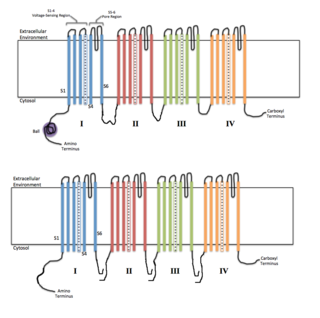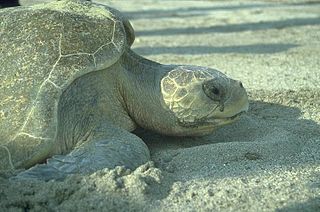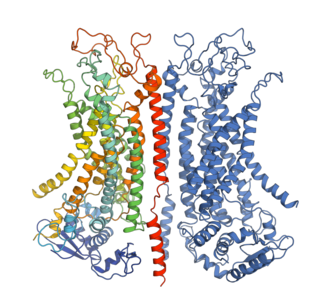Related Research Articles

Ion channels are pore-forming membrane proteins that allow ions to pass through the channel pore. Their functions include establishing a resting membrane potential, shaping action potentials and other electrical signals by gating the flow of ions across the cell membrane, controlling the flow of ions across secretory and epithelial cells, and regulating cell volume. Ion channels are present in the membranes of all cells. Ion channels are one of the two classes of ionophoric proteins, the other being ion transporters.

Aldosterone is the main mineralocorticoid steroid hormone produced by the zona glomerulosa of the adrenal cortex in the adrenal gland. It is essential for sodium conservation in the kidney, salivary glands, sweat glands, and colon. It plays a central role in the homeostatic regulation of blood pressure, plasma sodium (Na+), and potassium (K+) levels. It does so primarily by acting on the mineralocorticoid receptors in the distal tubules and collecting ducts of the nephron. It influences the reabsorption of sodium and excretion of potassium (from and into the tubular fluids, respectively) of the kidney, thereby indirectly influencing water retention or loss, blood pressure, and blood volume. When dysregulated, aldosterone is pathogenic and contributes to the development and progression of cardiovascular and kidney disease. Aldosterone has exactly the opposite function of the atrial natriuretic hormone secreted by the heart.

Voltage-gated ion channels are a class of transmembrane proteins that form ion channels that are activated by changes in the electrical membrane potential near the channel. The membrane potential alters the conformation of the channel proteins, regulating their opening and closing. Cell membranes are generally impermeable to ions, thus they must diffuse through the membrane through transmembrane protein channels. They have a crucial role in excitable cells such as neuronal and muscle tissues, allowing a rapid and co-ordinated depolarization in response to triggering voltage change. Found along the axon and at the synapse, voltage-gated ion channels directionally propagate electrical signals. Voltage-gated ion-channels are usually ion-specific, and channels specific to sodium (Na+), potassium (K+), calcium (Ca2+), and chloride (Cl−) ions have been identified. The opening and closing of the channels are triggered by changing ion concentration, and hence charge gradient, between the sides of the cell membrane.

Potassium-sparing diuretics refers to drugs that cause diuresis without causing potassium loss in the urine. They are typically used as an adjunct in management of hypertension, cirrhosis, and congestive heart failure. The steroidal aldosterone antagonists can also be used for treatment of primary hyperaldosteronism. Spironolactone, a steroidal aldosterone antagonist, is also used in management of female hirsutism and acne from PCOS or other causes.
Sodium channels are integral membrane proteins that form ion channels, conducting sodium ions (Na+) through a cell's membrane. They belong to the superfamily of cation channels.

Pseudohypoaldosteronism (PHA) is a condition that mimics hypoaldosteronism. However, the condition is due to a failure of response to aldosterone, and levels of aldosterone are actually elevated, due to a lack of feedback inhibition.

The epithelial sodium channel(ENaC), (also known as amiloride-sensitive sodium channel) is a membrane-bound ion channel that is selectively permeable to sodium ions (Na+). It is assembled as a heterotrimer composed of three homologous subunits α or δ, β, and γ, These subunits are encoded by four genes: SCNN1A, SCNN1B, SCNN1G, and SCNN1D. The ENaC is involved primarily in the reabsorption of sodium ions at the collecting ducts of the kidney's nephrons. In addition to being implicated in diseases where fluid balance across epithelial membranes is perturbed, including pulmonary edema, cystic fibrosis, COPD and COVID-19, proteolyzed forms of ENaC function as the human salt taste receptor.

Eccrine sweat glands are the major sweat glands of the human body, found in virtually all skin, with the highest density in palm and soles, then on the head, but much less on the torso and the extremities. In other mammals, they are relatively sparse, being found mainly on hairless areas such as foot pads. They reach their peak of development in humans, where they may number 200–400/cm2 of skin surface. They produce a clear, odorless substance, sweat, consisting primarily of water. These are present from birth. Their secretory part is present deep inside the dermis.

The salt gland is an organ for excreting excess salts. It is found in the cartilaginous fishes subclass elasmobranchii, seabirds, and some reptiles. Salt glands can be found in the rectum of sharks. Birds and reptiles have salt glands located in or on the skull, usually in the eyes, nose, or mouth. These glands are lobed containing many secretory tubules which radiate outward from the excretory canal at the center. Secretory tubules are lined with a single layer of epithelial cells. The diameter and length of these glands vary depending on the salt uptake of the species.

Neural precursor cell expressed developmentally downregulated gene 4-like (NEDD4L) or NEDD4-2 is an enzyme of the NEDD4 family. In human the protein is encoded by the NEDD4L gene. In mouse the protein is commonly known as NEDD4-2 and the gene Nedd4-2.

The SCNN1B gene encodes for the β subunit of the epithelial sodium channel ENaC in vertebrates. ENaC is assembled as a heterotrimer composed of three homologous subunits α, β, and γ or δ, β, and γ. The other ENAC subunits are encoded by SCNN1A, SCNN1G, and SCNN1D.

The SCNN1A gene encodes for the α subunit of the epithelial sodium channel ENaC in vertebrates. ENaC is assembled as a heterotrimer composed of three homologous subunits α, β, and γ or δ, β, and γ. The other ENAC subunits are encoded by SCNN1B, SCNN1G, and SCNN1D.

The SCNN1G gene encodes for the γ subunit of the epithelial sodium channel ENaC in vertebrates. ENaC is assembled as a heterotrimer composed of three homologous subunits α, β, and γ or δ, β, and γ. The other ENAC subunits are encoded by SCNN1A, SCNN1B, and SCNN1D.

Acid-sensing ion channel 1 (ASIC1) also known as amiloride-sensitive cation channel 2, neuronal (ACCN2) or brain sodium channel 2 (BNaC2) is a protein that in humans is encoded by the ASIC1 gene. The ASIC1 gene is one of the five paralogous genes that encode proteins that form trimeric acid-sensing ion channels (ASICs) in mammals. The cDNA of this gene was first cloned in 1996. The ASIC genes have splicing variants that encode different proteins that are called isoforms.

Prostasin is a protein that in humans is encoded by the PRSS8 gene.

Acid-sensing ion channel 2 (ASIC2) also known as amiloride-sensitive cation channel 1, neuronal (ACCN1) or brain sodium channel 1 (BNaC1) is a protein that in humans is encoded by the ASIC2 gene. The ASIC2 gene is one of the five paralogous genes that encode proteins that form trimeric acid-sensing ion channels (ASICs) in mammals. The cDNA of this gene was first cloned in 1996. The ASIC genes have splicing variants that encode different proteins that are called isoforms.

The SCNN1D gene encodes for the δ (delta) subunit of the epithelial sodium channel ENaC in vertebrates. ENaC is assembled as a heterotrimer composed of three homologous subunits α, β, and γ or δ, β, and γ. The other ENAC subunits are encoded by SCNN1A, SCNN1B, and SCNN1G.

Benzamil or benzyl amiloride is a potent blocker of the ENaC channel and also a sodium-calcium exchange blocker. It is a potent analog of amiloride, and is marketed as the hydrochloride salt. As amiloride, benzamil has been studied as a possible treatment for cystic fibrosis, although with disappointing results.

Antillatoxin (ATX) is a potent lipopeptide neurotoxin produced by the marine cyanobacterium Lyngbya majuscula. ATX activates voltage-gated sodium channels, which can cause cell depolarisation, NMDA-receptor overactivity, excess calcium influx and neuronal necrosis.

The Calcium-Dependent Chloride Channel (Ca-ClC) proteins (or calcium-activated chloride channels, are heterogeneous groups of ligand-gated ion channels for chloride that have been identified in many epithelial and endothelial cell types as well as in smooth muscle cells. They include proteins from several structurally different families: chloride channel accessory, bestrophin, and calcium-dependent chloride channel anoctamin channels ANO1 is highly expressed in human gastrointestinal interstitial cells of Cajal, which are proteins which serve as intestinal pacemakers for peristalsis. In addition to their role as chloride channels some CLCA proteins function as adhesion molecules and may also have roles as tumour suppressors. These eukaryotic proteins are "required for normal electrolyte and fluid secretion, olfactory perception, and neuronal and smooth muscle excitability" in animals. Members of the Ca-CIC family are generally 600 to 1000 amino acyl residues in length and exhibit 7 to 10 transmembrane segments.
References
- ↑ Shabbir W, Tzotzos S, Bedak M, Aufy M, Willam A, Kraihammer M, Holzner A, Czikora I, Scherbaum-Hazemi P, Fischer H, Pietschmann H, Fischer B, Lucas R, Lemmens-Gruber R (2015). "Glycosylation-dependent activation of epithelial sodium channel by solnatide". Biochem. Pharmacol. 98 (4): 740–53. doi:10.1016/j.bcp.2015.08.003. PMID 26254591.